Research on Topic Mining and Evolution Trends of Functional Agriculture Based on the BERTopic Model
Abstract
1. Introduction
2. Background
2.1. The Rise of Functional Agriculture
2.2. Topic Identification
2.3. Topic-Evolution Analysis
3. Research Methods
3.1. Research Approach
3.2. Data Acquisition and Preprocessing
3.3. BERTopic Modeling
- ①
- Text embedding: Using a pre-trained BERT model to convert each word in the text into word vectors, bringing semantically similar words closer in vector space.
- ②
- Text dimensionality reduction: Using the UMAP (Uniform Manifold Approximation and Projection) algorithm to reduce the dimensionality of word vectors, mapping them to a low-dimensional space while preserving important local and global structure information.
- ③
- Text clustering: Using the HDBSCAN (Hierarchical Density-Based Spatial Clustering of Applications with Noise) algorithm for clustering in the reduced vector space. HDBSCAN is a density-based clustering algorithm that finds clusters of arbitrary shape and is robust to noise and outliers. HDBSCAN has advantages over other clustering algorithms in dealing with clusters of different densities and noisy points, e.g., HDBSCAN identifies clusters by constructing a hierarchy of clusters and using stability, whereas DBSCAN may not be sufficiently effective in dealing with clusters of different densities. HDBSCAN identifies clusters through density connectivity, which is more able to capture the intrinsic structure of the data, whereas the k-means algorithm relies on distance for clustering, which will assign outliers to clusters and is more suitable for spherically distributed data than textual data.
- ④
- Topic representation: Using the c-TF-IDF method to calculate the importance of topic words in each topic cluster, extracting topic feature words based on maximum marginal relevance. The c-TF-IDF formula is as follows:
4. Result Analysis
4.1. Global Functional Agriculture Topic Identification
- (1)
- Agriculture and soil
- (2)
- Food and Health
- (3)
- Functional agricultural products
- (4)
- Precision Nutrition
- (5)
- Precision processing
4.2. Chinese Functional Agriculture Topic Identification
4.3. Comparative Analysis of Functional Agriculture Topic Evolution
- (1)
- Functional agriculture research topics are broad and detailed globally, while Chinese research topics are focused and in-depth. Global functional agriculture research covers a wide range of fields, with intensive research and abundant results. Plant chemical extraction, agricultural soil management, and precision nutrition are all areas of focus. In comparison, China’s research in the field of functional agriculture is more concentrated on specific topics, such as functional food development, bioactive substance detection, micronutrient-enrichment technology, soil health and pollution treatment, and crop stress-resistance improvement, showing focused and in-depth characteristics in functional agriculture research.
- (2)
- Functional agriculture focuses on agricultural nutrition and sustainable development, while China emphasizes food development, environmental protection, and crop cultivation. Research in the field of functional agriculture overall is based on plant chemical extraction and agricultural soil management, focusing on how to enhance the nutritional value of agricultural products and agricultural sustainability through endogenous nutrition and exogenous environment. It places more emphasis on technological innovation and interdisciplinary integration, such as the joint promotion of functional agriculture development by botany, nutrition, environmental science, and other disciplines. By contrast, China pays more attention to functional food development and agricultural environmental protection. The development trend of functional food dominating is related to China’s large population and urgent need for healthy food. In addition, Chinese research also focuses on soil heavy metal pollution, crop stress resistance, and biochar applications, indicating that China is implementing a dual-driven strategy of agricultural production and environmental health.
- (3)
- In the past five years, functional agriculture has focused on healthy food and disease prevention, while China places more emphasis on functional food and nutritional enhancement.
5. Conclusions and Outlook
- (1)
- Promoting interdisciplinary cooperation between functional agriculture and other technologies. The development of functional agriculture faces many complex problems, such as soil degradation, crop nutritional imbalance, and agricultural adaptability under climate change. These issues transcend the scope of a single discipline and require the combination of soil science, plant nutrition, ecology, environmental science, nutrition, and other fields to achieve technological breakthroughs and promote technological complementation and innovation. Currently, China’s functional agriculture is at a critical stage of development, needing to maintain development speed and expand research scope, and interdisciplinary cooperation will become the key to promoting the development of functional agriculture and solving complex agricultural challenges [51].
- (2)
- Developing agricultural products with Chinese characteristics and forming Chinese functional agricultural product brands. China has rich agricultural resources and local characteristic agricultural products, such as black fungus from Northeast China, Pu’er tea from Yunnan, red dates from Xinjiang, Tieguanyin tea from Fujian, and chili peppers from Sichuan. Currently, selenium-rich agricultural products have become representatives of China’s functional agriculture, such as selenium-rich rice, selenium-rich tea, and selenium-rich water. However, functional agriculture is not limited to the selenium-rich industry. The “single prosperity” of selenium-rich products in the field indicates an imbalance in the product types of China’s functional agriculture. Therefore, in-depth research and development of characteristic agricultural resources need to be conducted in the future. And by transforming those scientific achievements into competitive functional products, it will reflect the diversity of Chinese agriculture, and promote farmers’ income and rural economic development.
- (3)
- Utilizing smart farming technology to boost functional agriculture. With the advancement of digital technologies and the rise of the AI4S research paradigm [52,53], smart agricultural technology is becoming an important driving force for the innovative development of functional agriculture [54]. Smart agricultural technology is represented by big data analysis, Internet of Things, artificial intelligence, agricultural robots, intelligent breeding, soil monitoring, pest and disease identification, intelligent expert systems, etc. [55], providing a technical foundation for the upgrade of functional agriculture, enabling it to develop in a more precise, high-quality, and sustainable direction. Therefore, smart agriculture technology should be integrated with functional agriculture, such as combining deep learning algorithms and near-infrared calibration platforms with the Internet of Things (IoT), which can be used to rapidly and quantitatively detect selenium content in rice samples [56].
Author Contributions
Funding
Institutional Review Board Statement
Data Availability Statement
Conflicts of Interest
References
- Zhang, X. Disruptive Changes and the Post-Library Era: Toward Supply-side Structure Reform of Knowledge Services. Zhongguo Tushuguan Xuebao 2018, 44, 4–16. [Google Scholar]
- Rotruck, J.T.; Pope, A.L.; Ganther, H.E.; Swanson, A.B.; Hafeman, D.G.; Hoekstra, W.G. Selenium: Biochemical Role as a Component of Glutathione Peroxidase. Science 1973, 179, 588–590. [Google Scholar] [CrossRef] [PubMed]
- WHO; FAO. Vitamin and Mineral Requirements in Human Nutrition, 2nd ed.; World Health Organization: Geneva, Switzerland, 2004; Available online: https://www.who.int/publications/i/item/9241546123 (accessed on 14 July 2024).
- Feinberg, A.; Stenke, A.; Peter, T.; Hinckley, E.L.; Driscoll, C.T.; Winkel, L.H. Reductions in the deposition of sulfur and selenium to agricultural soils pose risk of future nutrient deficiencies. Commun. Earth Environ. 2021, 2, 101. [Google Scholar] [CrossRef]
- Yin, X.; Zhao, Q. Key Scientific Issues and Development Strategies of Functional Agriculture. Kexue Tongbao 2022, 67, 459–460. [Google Scholar]
- Zhao, Q.; Yin, X. Functional Agriculture; Kexue Chubanshe: Beijing, China, 2016. [Google Scholar]
- Yin, X. (Ed.) 100 FAQs of Functional Agriculture; Kexue Chubanshe: Beijing, China, 2020. [Google Scholar]
- Lee, C.; Lee, G.; Jang, M. Dependency structure language model for topic detection and tracking. Inf. Process. Manag. 2007, 43, 1249–1259. [Google Scholar] [CrossRef]
- Deerwester, S.C.; Dumais, S.T.; Landauer, T.K.; Furnas, G.W.; Harshman, R.A. Indexing by Latent Semantic Analysis. J. Am. Soc. Inf. Sci. 1990, 41, 391–407. [Google Scholar] [CrossRef]
- Blei, D.M.; Ng, A.Y.; Jordan, M.I. Latent Dirichlet Allocation. J. Mach. Learn. Res. 2003, 3, 993–1022. [Google Scholar]
- Blei, D.; Lafferty, J. Dynamic topic models. In ICML ’06, Proceedings of the 23rd International Conference on Machine Learning, Pittsburgh, PA, USA, 25–29 June 2006; Association for Computing Machinery: New York, NY, USA, 2006; pp. 113–120. [Google Scholar]
- Maarten, G. BERTopic: Neural topic modeling with a class-based TF-IDF procedure. arXiv 2022, arXiv:2203.05794. [Google Scholar]
- Devlin, J.; Chang, M.; Lee, K.; Toutanova, K. BERT: Pre-training of Deep Bidirectional Transformers for Language Understanding. arXiv 2018, arXiv:1810.04805. [Google Scholar]
- Abuzayed, A.; Al-Khalifa, H. BERT for arabic topic modeling: An experimental study on BERTopic technique. Procedia Comput. Sci. 2021, 189, 191–194. [Google Scholar] [CrossRef]
- Jeon, E.; Yoon, N.; Sohn, S. Exploring new digital therapeutics technologies for psychiatric disorders using BERTopic and PatentSBERTa. Technol. Forecast. Soc. Change 2023, 186, 122130. [Google Scholar] [CrossRef]
- Zhu, Q.; Leng, F. Analysis of topic evolution based on co-citation of documents on the main citation path. J. China Soc. Sci. Tech. Inf. 2014, 33, 498–506. [Google Scholar]
- Lei, H. Appling information entropy to quantitative analysis on competitive intelligence. J. Inf. 2008, 5, 73–75. [Google Scholar]
- Qiu, J.; H, B.; Xu, Z.; Xiao, B. Topic Mining and Comparative Analysis of Discourse Power Research in China and Overseas Based on DTM Model. Qingbao Lilun Yu Shijian 2023, 46, 24–34. [Google Scholar]
- Ma, J.; Wang, L.; Zhang, Y.; Yuan, W.; Guo, W. An integrated latent Dirichlet allocation and Word2vec method for generating the topic evolution of mental models from global to local. Expert Syst. Appl. 2023, 212, 118695. [Google Scholar] [CrossRef]
- Sundaresan, P.; Lee, T. Disposable sensor electrode modified with strontium vanadate-graphene nanocomposites for rapid analysis of hazardous insecticide carbofuran in environmental media samples. J. Environ. Chem. Eng. 2023, 11, 110345. [Google Scholar] [CrossRef]
- Bai, N.; Zhang, H.; Zhou, S.; Sun, H.; Zhao, Y.; Zheng, X.; Li, S.; Zhang, J.; Lv, W. Long-term effects of straw return and straw-derived biochar amendment on bacterial communities in soil aggregates. Sci. Rep. 2020, 10, 7891. [Google Scholar] [CrossRef]
- Sherin, D.; Satheeshkumar, K.; Manojkumar, T. Molecular simulations of CRANADs to disclose a specific cyanide sensor in aqueous media. Comput. Theor. Chem. 2022, 1217, 113894. [Google Scholar] [CrossRef]
- Alahmad, T.; Neményi, M.; Nyéki, A. Applying IoT Sensors and Big Data to Improve Precision Crop Production: A Review. Agronomy 2023, 13, 2603. [Google Scholar] [CrossRef]
- Meng, Z.; Zhang, L.; Wang, H.; Ma, X.; Li, H.; Zhu, F. Research and Design of Precision Fertilizer Application Control System Based on PSO-BP-PID Algorithm. Agriculture 2022, 12, 1395. [Google Scholar] [CrossRef]
- Maleki, S.; Razavi, S.; Yadav, H. Diabetes and seeds: New horizon to promote human nutrition and anti-diabetics compounds in grains by germination. Crit. Rev. Food Sci. Nutr. 2023, 63, 8457–8477. [Google Scholar] [CrossRef] [PubMed]
- Bano, A.; Gupta, A.; Rai, S.; Sharma, S. Elucidation of Bioactive Potential of Two Commonly Grown North Indian Psidium guajava viz., Lalit and Shweta against Pathogenic Foodborne and MDR Bacteria. Biointerface Res. Appl. Chem. 2021, 11, 14090–14102. [Google Scholar]
- Abdi, R.; Joye, I. Prebiotic Potential of Cereal Components. Foods 2021, 10, 2338. [Google Scholar] [CrossRef]
- Abu-Serie, M.; Habashy, N. The ameliorating effect of the combined extract from Greek Thymus vulgaris and bee’s honey on the hydrocortisone-induced osteoporosis in rat bone cells via modulating the bone turnover, oxidative stress, and inflammation. RSC Adv. 2018, 8, 28341–28355. [Google Scholar] [CrossRef]
- Simon, A.; Mazhar, S.; Khokhlova, E.; Leeuwendaal, N.; Phipps, C.; Deaton, J.; Rea, K.; Colom, J. Solarplast®-An Enzymatically Treated Spinach Extract. Plants 2023, 12, 2678. [Google Scholar] [CrossRef]
- Waseem, M.; Akhtar, S.; Qamar, M.; Saeed, W.; Ismail, T.; Esatbeyoglu, T. Effect of Thermal and Non-Thermal Processing on Nutritional, Functional, Safety Characteristics and Sensory Quality of White Cabbage Powder. Foods 2022, 11, 3802. [Google Scholar] [CrossRef] [PubMed]
- Shree, B.; Kumar, S.; Priyanka; Sharma, S.; Katoch, V. Functional significance of underutilized high value cruciferous vegetables- an exotic gleam in the gloomy guise of their functional importance. South Afr. J. Bot. 2022, 145, 420–437. [Google Scholar] [CrossRef]
- Zhang, D.; He, N.; Yang, X.; Zhang, D.; Li, Q.; Xiong, Y. Research advance on the important role of selenoprotein in human health. Chin. Sci. Bull. 2022, 67, 473–480. [Google Scholar] [CrossRef]
- Singh, A.; Shukla, G.; Gaurav, S.; Rani, P. Nano-Biofortification of Zinc in Potato (Solanum tuberosum L.) and Tomato (Solanum lycopersicum L.) Crops. Macromol. Symp. 2023, 407, 2100403. [Google Scholar] [CrossRef]
- Parra-Torrejón, B.; Cáceres, A.; Sánchez, M.; Sainz, L.; Guzmán, M.; Bermúdez-Perez, F.; Ramírez-Rodríguez, G.; Delgado-López, J. Multifunctional Nanomaterials for Biofortification and Protection of Tomato Plants. Environ. Sci. Technol. 2023, 57, 14950–14960. [Google Scholar] [CrossRef]
- Deliboran, A. Selenium Biofortification of Grain Maize Through Foliar Application of Sodium Selenate: Selenium Accumulation and Recovery by the Grain. Commun. Soil Sci. Plant Anal. 2023, 54, 1564–1581. [Google Scholar] [CrossRef]
- Zuluaga, M.; Cardarelli, M.; Rouphael, Y. Iron nutrition in agriculture: From synthetic chelates to biochelates. Sci. Hortic. 2023, 312, 111833. [Google Scholar] [CrossRef]
- Kaur, M.; Sharma, S.; Kaur, R.; Kaur, J.; Singh, A. Effect of UV-B irradiation on bioconversion of ergosterol to vitamin D2 and its impact on nutritional properties of oyster mushroom (Pleurotus florida). Int. J. Food Sci. Technol. 2023, 58, 5114–5120. [Google Scholar] [CrossRef]
- Jha, A.K.; Sit, N. Extraction of bioactive compounds from plant materials using combination of various novel methods: A review. Trends Food Sci. Technol. 2022, 119, 579–591. [Google Scholar] [CrossRef]
- Sarkar, T.; Mukherjee, M.; Roy, S.; Chakraborty, R. Palm sap sugar an unconventional source of sugar exploration for bioactive compounds and its role on functional food development. Heliyon 2023, 9, e14788. [Google Scholar] [CrossRef]
- Farhat, M.; Amor, G.; Beji-Serairi, R.; Selmi, S.; Khammassi, S.; Saidani-Tounsi, M.; Abdelly, C. Enhancement of nutritional quality and antioxidant properties of Lepidium sativum L. sprouts by salt treatment and domestic cooking. Int. J. Gastron. Food Sci. 2023, 32, 100736. [Google Scholar] [CrossRef]
- Torres Sánchez, E.G.; Hernández-Ledesma, B.; Gutiérrez, L.F. Sacha Inchi Oil Press-cake: Physicochemical Characteristics, Food-related Applications and Biological Activity. Food Rev. Int. 2021, 39, 148–159. [Google Scholar] [CrossRef]
- Kaba, B.; Yıkılkan, Y.; Pashazadeh, H.; Redha, A.; Koca, I. Production of cornelian cherry (Cornus mas L.) pulp powder by foam-mat drying: Analysis of physicochemical and antioxidant properties. Biomass Convers. Biorefinery 2023. [Google Scholar] [CrossRef]
- Wang, L.; Li, C.; Luo, K. Biosynthesis and metabolic engineering of isoflavonoids in model plants and crops: A review. Front Plant Sci. 2024, 15, 1384091. [Google Scholar] [CrossRef] [PubMed]
- Dawar, K.; Mian, I.; Khan, S.; Zaman, A.; Danish, S.; Liu, K.; Harrison, M.; Saud, S.; Hassan, S.; Nawaz, T.; et al. Alleviation of cadmium toxicity and fortification of zinc in wheat cultivars cultivated in Cd contaminated soil. South Afr. J. Bot. 2023, 162, 611–621. [Google Scholar] [CrossRef]
- Faizan, M.; Bhat, J.A.; El-Serehy, H.A.; Moustakas, M.; Ahmad, P. Magnesium Oxide Nanoparticles (MgO-NPs) Alleviate Arsenic Toxicity in Soybean by Modulating Photosynthetic Function, Nutrient Uptake and Antioxidant Potential. Metals 2022, 12, 2030. [Google Scholar] [CrossRef]
- Wu, P.; Wang, Z.; Wang, H.; Bolan, S.; Wang, Y.; Chen, W. Visualizing the emerging trends of biochar research and applications in 2019: A scientometric analysis and review. Biochar 2020, 2, 135–150. [Google Scholar] [CrossRef]
- Zenga, Y.; Ali, M.K.; Du, J.; Li, X.; Yang, X.; Yang, J.; Pu, X.; Yang, L.; Hong, J.; Mou, B.; et al. Resistant Starch in Rice: Its Biosynthesis and Mechanism of Action Against Diabetes-Related Diseases. Food Rev. Int. 2022, 39, 4364–4387. [Google Scholar] [CrossRef]
- Rehman, A.; Farooq, M.; Ullah, A.; Nawaz, A.; Din, M.; Shahzad, B. Seed priming with zinc sulfate and zinc chloride affects physio-biochemical traits, grain yield and biofortification of bread wheat. Crop Pasture Sci. 2022, 73, 449–460. [Google Scholar] [CrossRef]
- Shi, T.; Gao, Y.; Xu, A.; Wang, R.; Lyu, R.; Sun, Y.; Chen, L.; Liu, Y.; Luo, R.; Wang, H.; et al. A fast breeding strategy creates fragrance- and anthocyanin-enriched rice lines by marker-free gene-editing and hybridization. Mol. Breed. 2023, 43, 23. [Google Scholar] [CrossRef]
- Zhao, Q. Agricultural Science & Technology in China: A Roadmap to 2050; Kexue Chubanshe: Beijing, China, 2009. [Google Scholar]
- Impa, S.M.; Johnson-Beebout, S.E. Mitigating zinc deficiency and achieving high grain Zn in rice through integration of soil chemistry and plant physiology research. Plant Soil. 2012, 361, 3–41. [Google Scholar] [CrossRef]
- Li, G. AI4R: The fifth scientific research paradigm. Zhongguo Kexueyuan Yuankan 2024, 39, 1–9. [Google Scholar]
- Zhao, R.; Li, T.; Guan, Z.; Xian, G.; Kou, Y.; Sun, T. Bidirectional Empowerment Between Knowledge Service and New Quality Productive Forces Theoretical Interpretation and Practical Path. Nongye Tushu Qingbao Xuebao 2024, 36, 4–14. [Google Scholar]
- Zhao, R.; Yang, C.; Zheng, J.; Li, J.; Wang, J. Agricultural Intelligent Knowledge Service: Overview and Future Perspectives. Zhihui Nongye 2022, 4, 105–125. [Google Scholar]
- Li, D.; Li, G.; Xu, S.; Chen, W. Research and Prospects on the Agricultural Development Paradigm Driven by GPT Technology. Nongye Zhanwang 2023, 19, 73–80. [Google Scholar]
- Cai, K.; Chen, H.; Ai, W.; Miao, X.; Lin, Q.; Feng, Q. Feedback Convolutional Network for Intelligent Data Fusion Based on Near-Infrared Collaborative IoT Technology. IEEE Trans. Ind. Inform. 2022, 18, 1200–1209. [Google Scholar] [CrossRef]
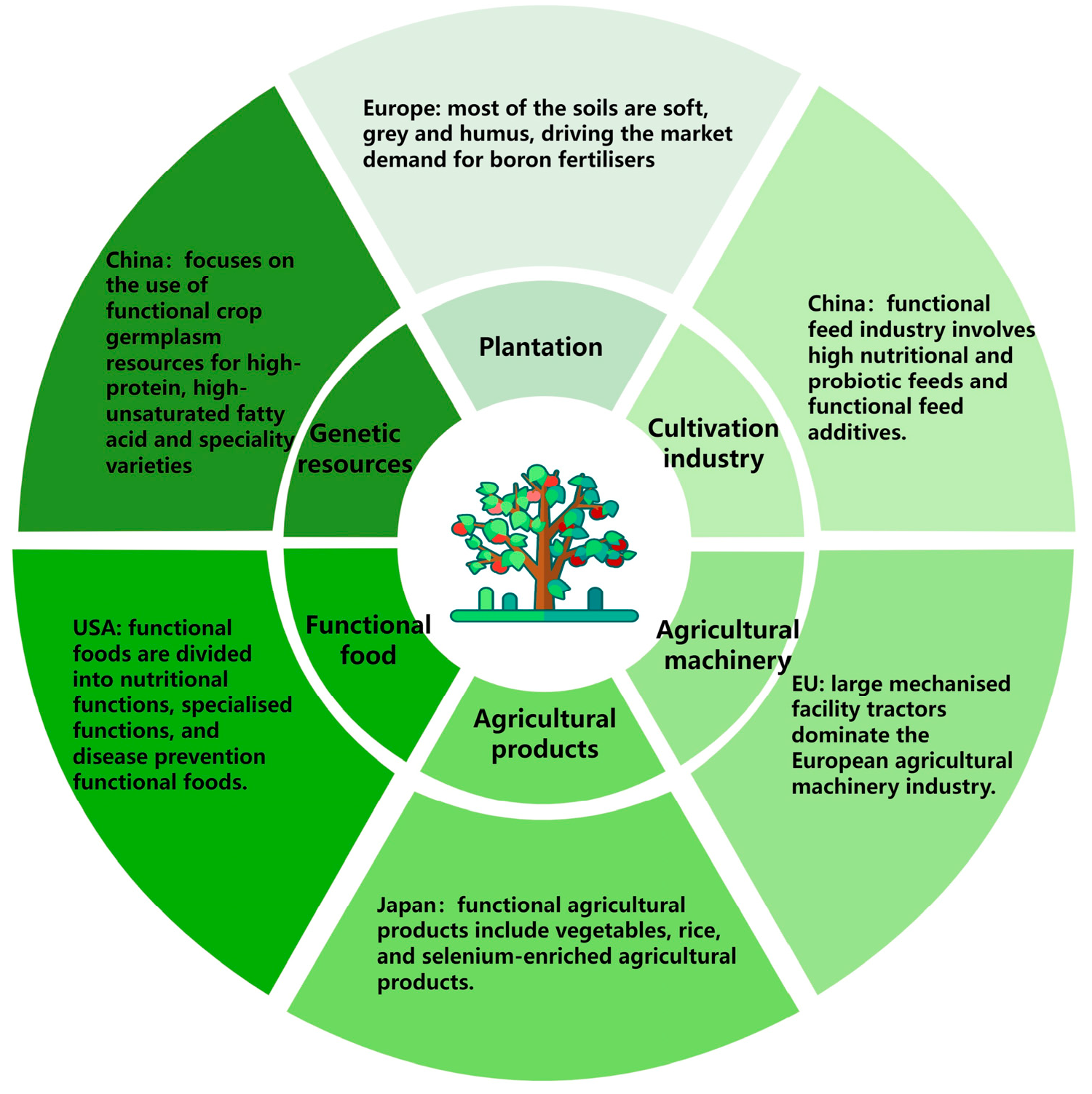
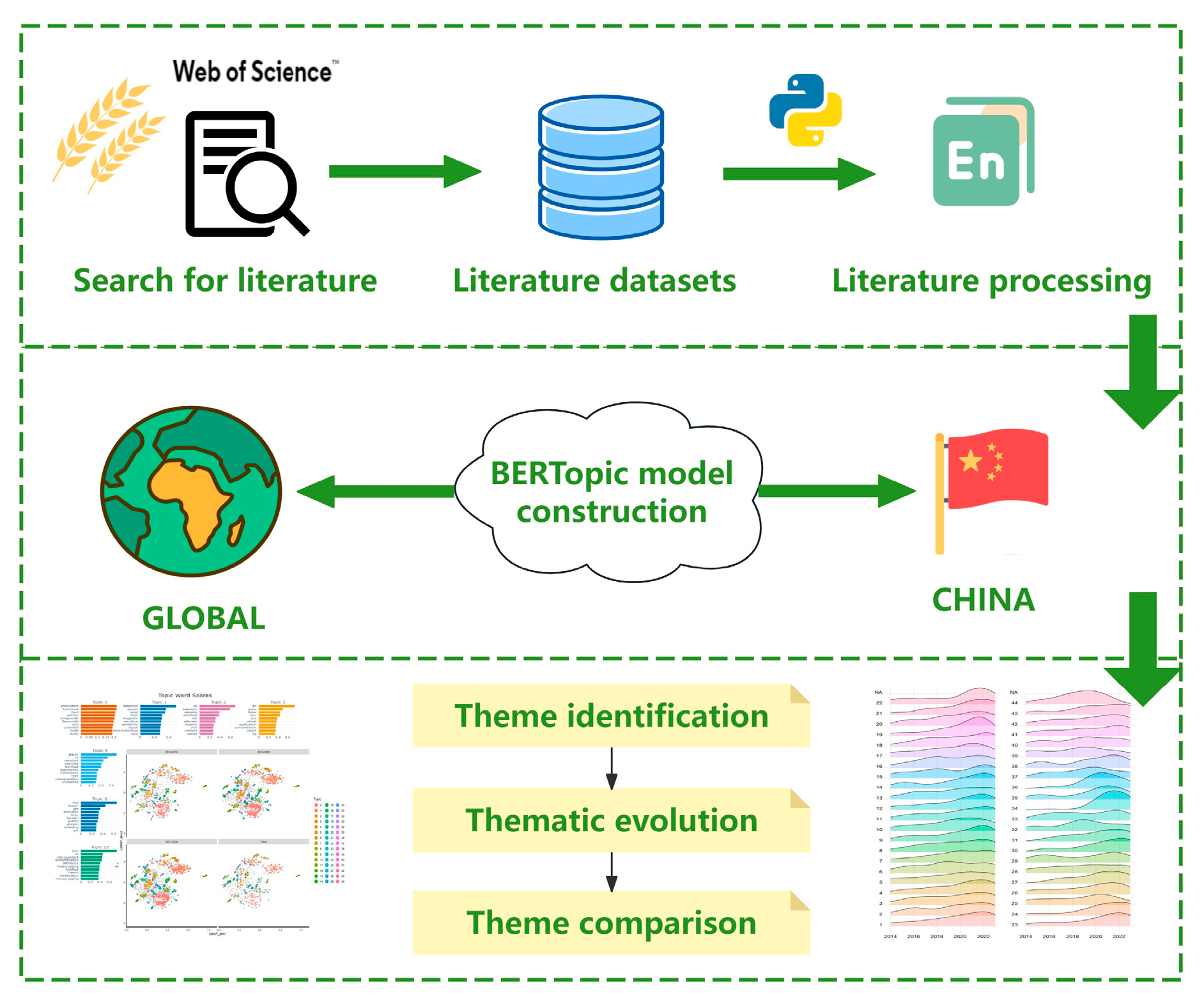
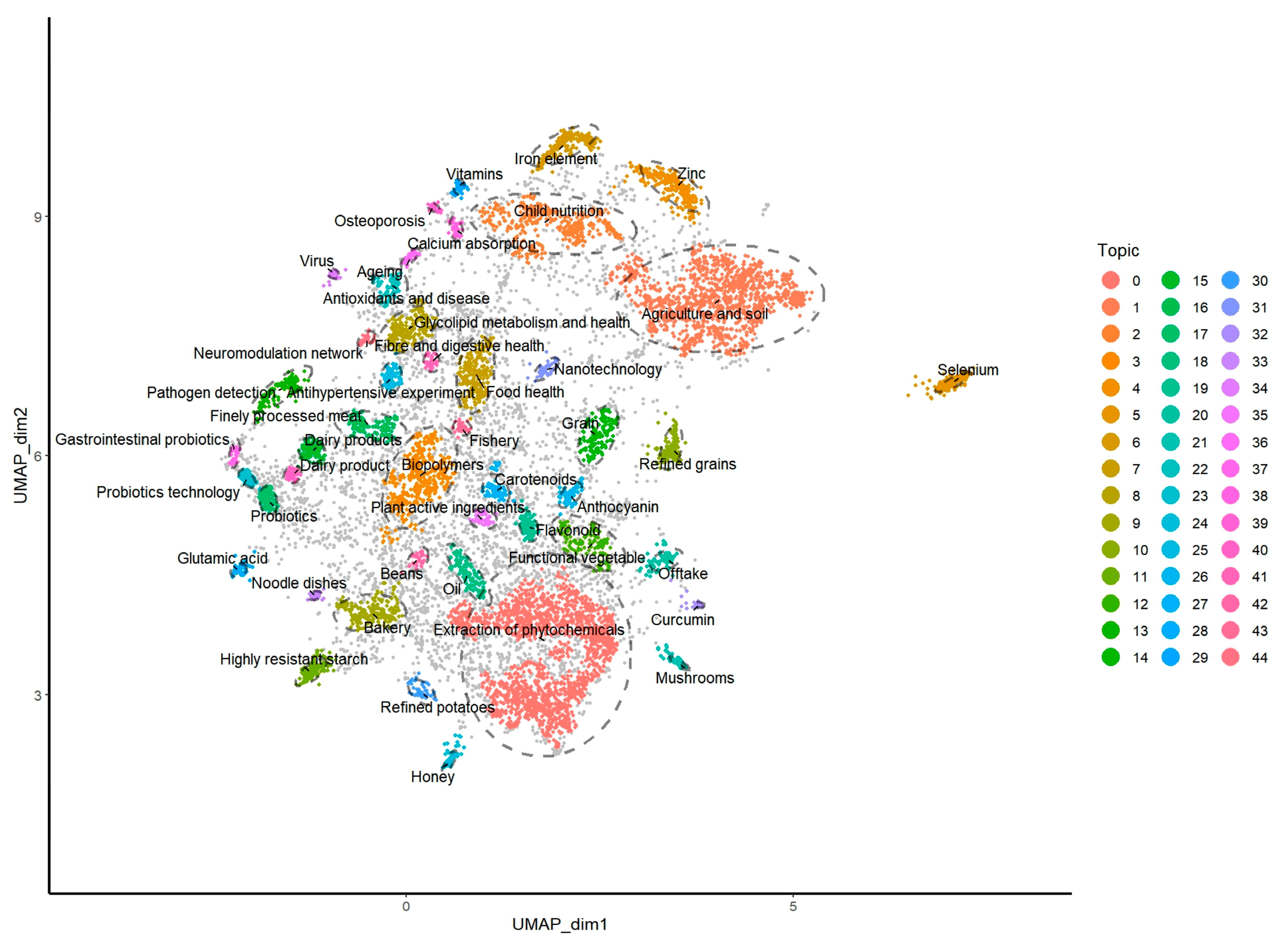
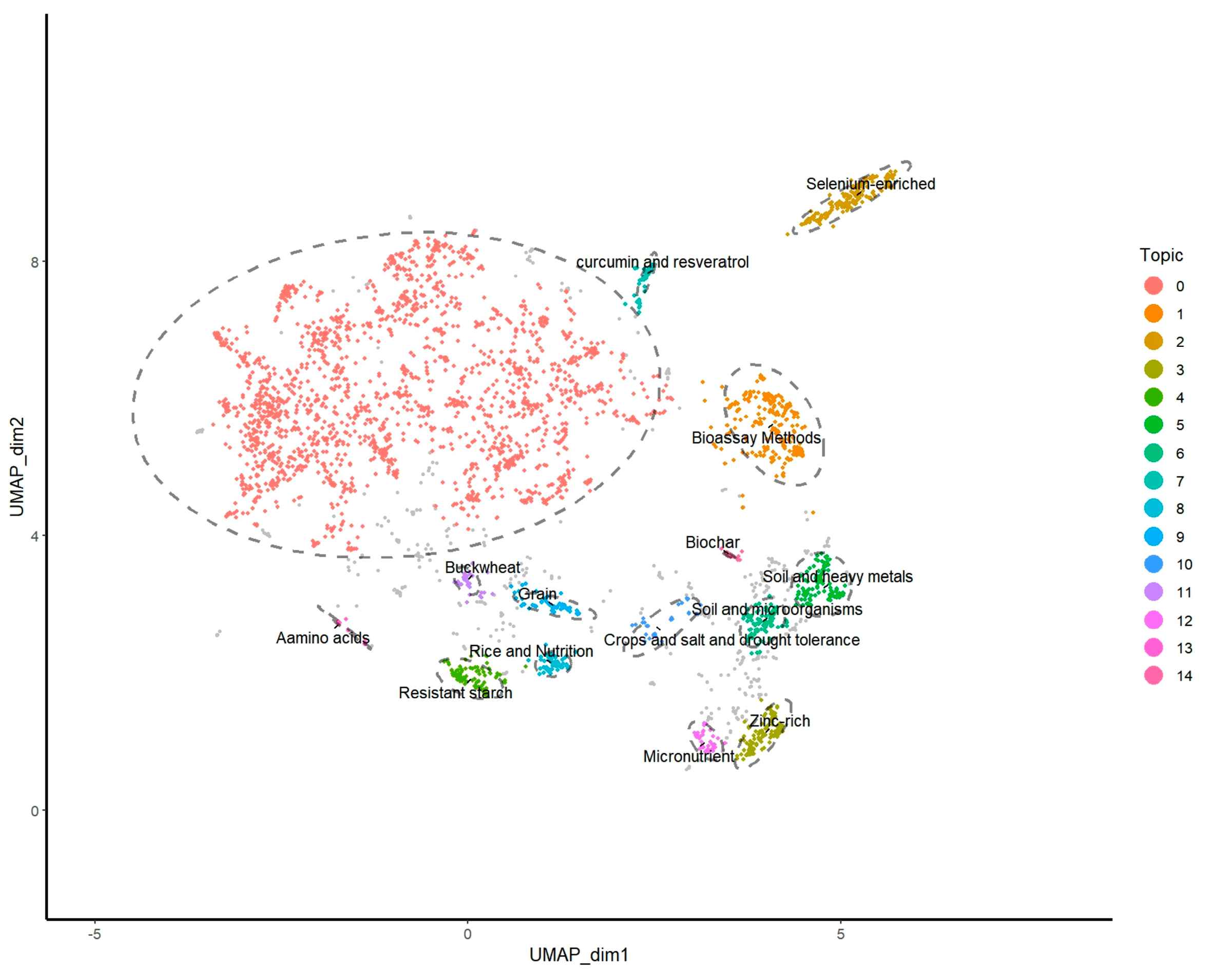
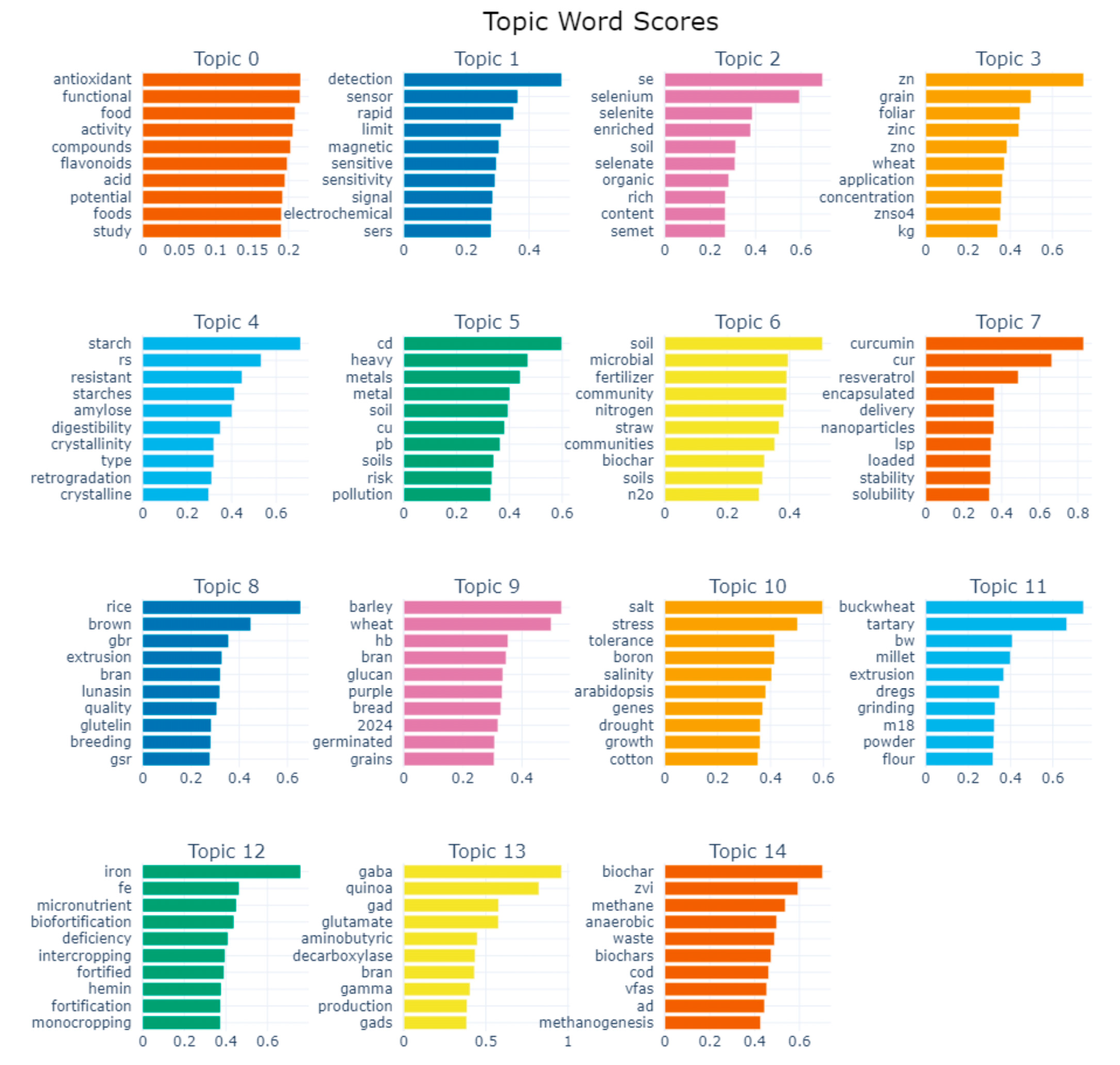


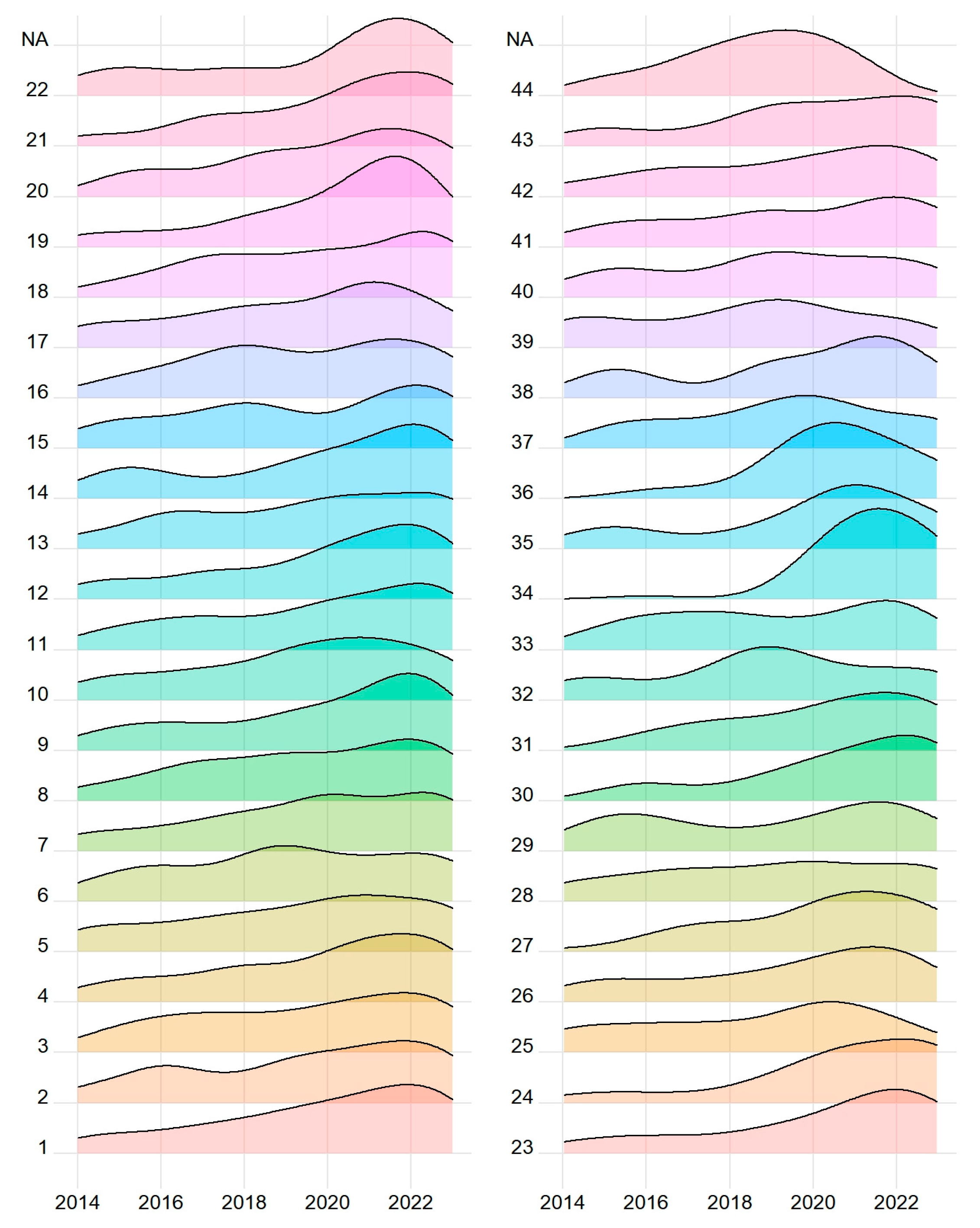
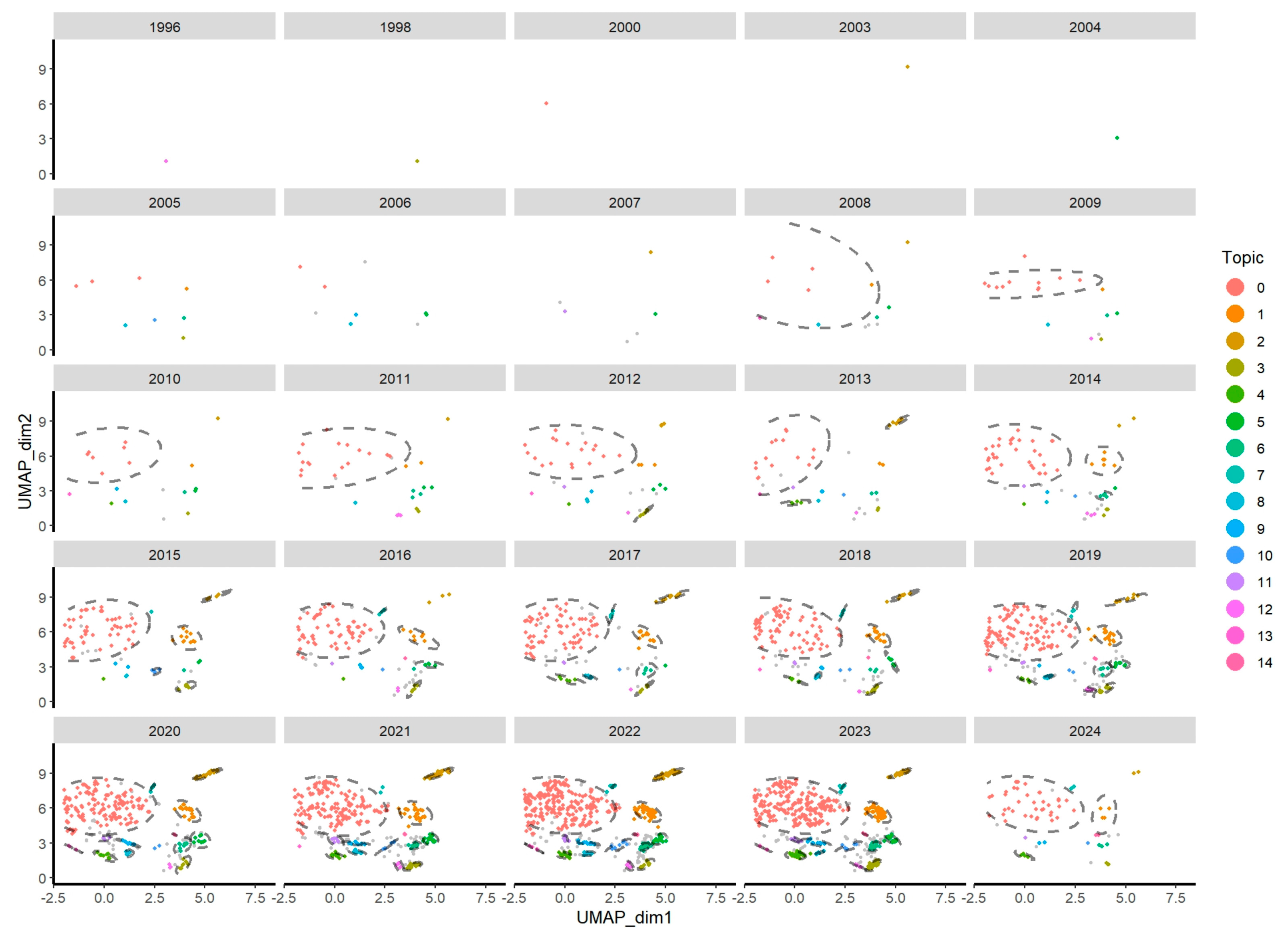
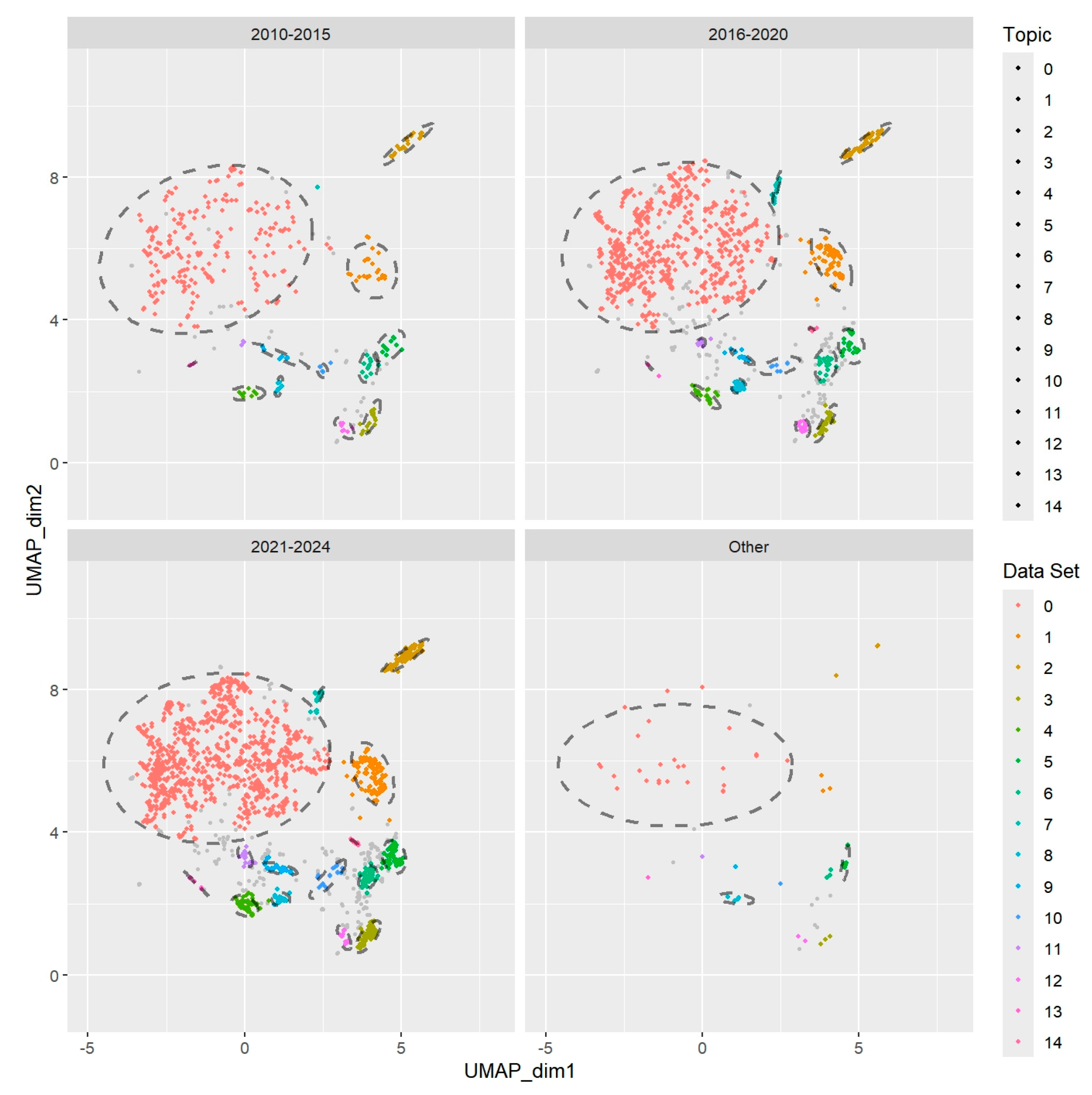
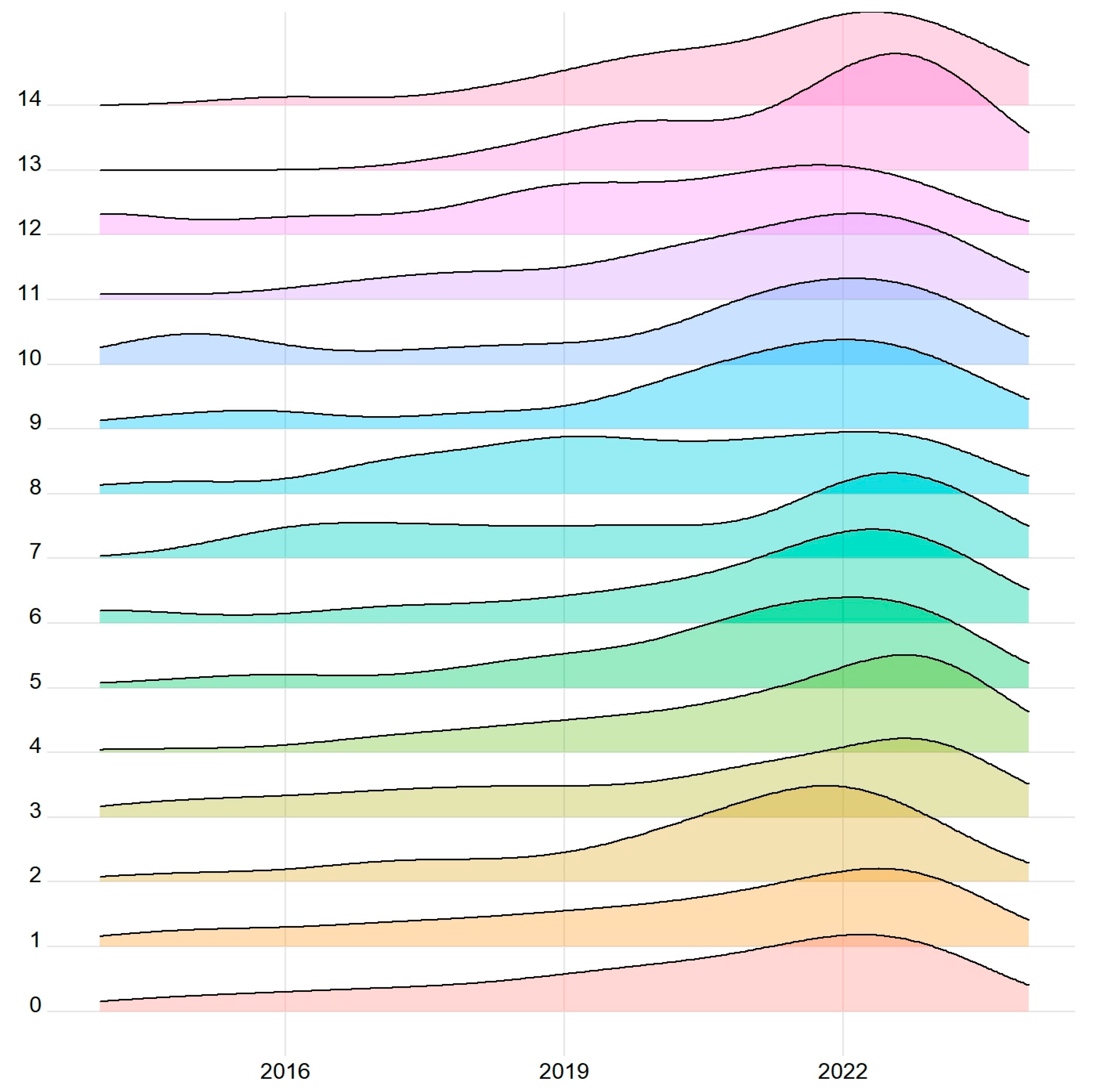
| Topic Cluster | Topic Name | Number of Topics Containing Literature | Proportion | Topic Feature Words |
|---|---|---|---|---|
| Agriculture and soil | Topic1: Agriculture and soil | 1274 | 8.09% | environmental, soil, wastewater, ecological, agricultural, agriculture, fertilizers, organic, sustainable |
| Food and Health | Topic8: Glycolipid metabolism and health | 220 | 1.40% | metabolic, obesity, metabolism, diet, adipogenesis, adipocytes, dietary, diabetics, diabetic |
| Topic13: Pathogen detection | 150 | 0.95% | bacterial, bacteria, biosensor, coli, pathogens, salmonella, pathogen, biofilm, immunosensor | |
| Topic17: Probiotics | 112 | 0.71% | probiotic, lactobacillus, lactobacilli, synbiotic, lactiplantibacillus, soymilk, bacteria, fermented, lactis | |
| Topic22: Antioxidants and disease | 85 | 0.54% | inflammation, inflammatory, disease, chronic, pathogenesis, disorders, dysfunction, antioxidant, neuroinflammation | |
| Topic25: Antihypertensive experiment | 79 | 0.50% | hypertension, hypertensive, antihypertensive, arterial, acetaminophen, fructose, glutathione, dose, insulin, glucose | |
| Topic37: Gastrointestinal probiotics | 42 | 0.26% | microbiome, microbiol, microbial, prebiotic, bacteria, bacterial, probiotic, digestible, gastrointestinal | |
| Topic38: Calcium absorption | 41 | 0.26% | calcium, dietary, calcification, diets, intake, foods, phosphate, consumption, carbonate | |
| Topic39: Osteoporosis | 38 | 0.24% | osteoporosis, osteoblastic, osteoclast, osteoclasts, bone, osteo, osteocalcin | |
| Topic41: Fiber and digestive health | 35 | 0.22% | fiber, dietary, diets, digestive, cholesterol, digestion | |
| Functional agricultural products | Topic11: Highly resistant starch | 184 | 1.17% | starch, digestible, potato, glucose, glycemic, gelatinized, cooked, carbohydrate |
| Topic12: Functional vegetable | 151 | 0.96% | vegetable, tomatoes, tomatine, cabbage, cultivars, fruit, antioxidant | |
| Topic15: Dairy products | 128 | 0.81% | dairy, milk, lactating, lactation, lactose, lactostatin, cow, nutritional | |
| Topic19: Flavonoid | 102 | 0.65% | flavonoids, flavonols, flavanone, flavonol, flavanones, flavones, flaxseed | |
| Topic20: Offtake | 98 | 0.62% | seaweeds, algae, ulva, sargassum, brown, marine, queensland, laminarin, caulerpa | |
| Topic21: Mushrooms | 93 | 0.59% | mushroom, edible, extracts, cultivated, glucans, culinary, glucan, medicinal, nutritional | |
| Precision Nutrition | Topic4: Zinc | 327 | 2.08% | zinc, zn, znonps, maize, znso4, grains, soil, wheat, soils, grain |
| Topic5: Selenium | 298 | 1.89% | se, selenium, selenate, selenite, selenomethionine, enriched, biofortification, sodium, element, inorganic | |
| Topic6: Iron element | 242 | 1.54% | iron, fe, anemia, ferritin, deficiency, fortified, ferrous, children, hemoglobin, anaemia | |
| Topic27: Carotenoids | 74 | 0.47% | carotenoids, bioavailability, phytoene, carotene, carnosinase, carnosine, phytofluene, carotenoid | |
| Topic29: Vitamins | 62 | 0.39% | vitamin, hypovitaminosis, hydroxyvitamin, supplements, dehydrocholesterol, supplementation, supplement, d3, d2, osteoporosis | |
| Topic35: Plant active ingredients | 58 | 0.37% | resveratrol, zeaxanthin, gliadin, fructofuranoside, talassemia, xanthophyll, biotecnologie, microparticles, phosphatidylglycerol, thalassemia | |
| Precision processing | Topic0: Extraction of phytochemicals | 1765 | 11.21% | phytochemicals, cultivars, citrus, fruit, extracts, phenolics, mango, bioactive |
| Topic3: Biopolymers | 404 | 2.57% | lipids, biopolymers, oils, polymers, microcapsules, emulsification, acids | |
| Topic16: Finely processed meat | 114 | 0.72% | protein, meat, peptides, bioactive, fatty, burgers, beef | |
| Topic30: Refined potatoes | 58 | 0.37% | sweetpotatoes, batatas, potatoes, cultivars, flour, cultivar, frying, cooking | |
| Topic31: Nanotechnology | 55 | 0.34% | nanotechnology, nanotechnological, nanoscience, nanofertilizers, nanoscale, nanosensors, nanofoods, technologies |
Disclaimer/Publisher’s Note: The statements, opinions and data contained in all publications are solely those of the individual author(s) and contributor(s) and not of MDPI and/or the editor(s). MDPI and/or the editor(s) disclaim responsibility for any injury to people or property resulting from any ideas, methods, instructions or products referred to in the content. |
© 2024 by the authors. Licensee MDPI, Basel, Switzerland. This article is an open access article distributed under the terms and conditions of the Creative Commons Attribution (CC BY) license (https://creativecommons.org/licenses/by/4.0/).
Share and Cite
Lin, Q.; Xin, Z.; Peng, S.; Zhao, R.; Nie, Y.; Chen, Y.; Yin, X.; Xian, G.; Zhang, Q. Research on Topic Mining and Evolution Trends of Functional Agriculture Based on the BERTopic Model. Agriculture 2024, 14, 1691. https://doi.org/10.3390/agriculture14101691
Lin Q, Xin Z, Peng S, Zhao R, Nie Y, Chen Y, Yin X, Xian G, Zhang Q. Research on Topic Mining and Evolution Trends of Functional Agriculture Based on the BERTopic Model. Agriculture. 2024; 14(10):1691. https://doi.org/10.3390/agriculture14101691
Chicago/Turabian StyleLin, Qiao, Zhulin Xin, Shuang Peng, Ruixue Zhao, Yingli Nie, Youtao Chen, Xuebin Yin, Guojian Xian, and Qiang Zhang. 2024. "Research on Topic Mining and Evolution Trends of Functional Agriculture Based on the BERTopic Model" Agriculture 14, no. 10: 1691. https://doi.org/10.3390/agriculture14101691
APA StyleLin, Q., Xin, Z., Peng, S., Zhao, R., Nie, Y., Chen, Y., Yin, X., Xian, G., & Zhang, Q. (2024). Research on Topic Mining and Evolution Trends of Functional Agriculture Based on the BERTopic Model. Agriculture, 14(10), 1691. https://doi.org/10.3390/agriculture14101691







